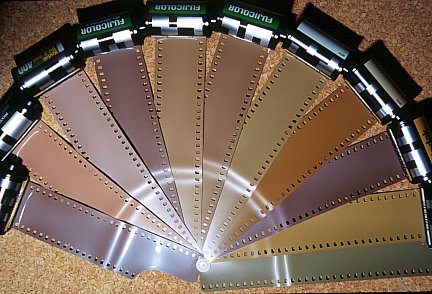TTL Flash and Film Reflectivity
Moose Peterson has an excellent tutorial on the use of flash on his website, and there’s little that one can add to that. So, for overall information on TTL flash work, check out excellent essay.
But there is one thing that’s not covered there, and does not seem to be generally covered in books and articles about TTL flash. And that is the impact of film reflectivity on TTL systems that use "off the film" (OTF) metering…
Well, the idea is simple…
TTL (through the lens) metered flash works by cutting off the flash when the correct exposure level is achieved. Basically, the camera fires the flash and a sensor monitors how much light is put out. Once the correct amount of light has been reached, the camera shuts off the flash.
In many cameras, the sensor that monitors the amount of light put out by the flash are actually measuring the light reflected back off the film – hence the phrase, "off the film" metering. Obviously, when you reflect light off something, the degree of reflectivity makes a difference.
The image below shows a potpourri of different brands and types of films. I just raided my freezer and film bag and pulled out one of everything there… As you can see – the different film types are pretty different in color and overall darkness or lightness. In fact, when I ran a spot meter over the different types, there was over 1.5 stops worth of difference in the meter readings from the lightest to the darkest film emulsion.
Does this have an effect on the exposures gotten via TTL flash? Absolutely! I learned about this while trying to diagnose exposure problems with a roll of Kodachrome it took last summer. I was out taking insect macros and on this particular day had shot two rolls of print film, one roll of Kodachrome, and one role of Kodak Elitechrome EBX. All of the images were properly exposed, except for the roll of Kodachrome – which was consistently under exposed. Since the roll of Kodachrome was shot in the middle of the sequence, I could not figure out what change in technique or equipment settings could account for the exposure problem.
Then the question about TTL flash came to mind. When I compared the Kodachrome to the other film types, the hypothesis was confirmed. Kodachrome is a very light colored (more reflective) film. So… more light bounces off it, the TTL meter cuts out the flash that much sooner, and as a result the images were slightly under exposed.
Of course – for print film a stop or even a stop and a half of mis-exposure will not be catastrophic. But for fairly narrow latitude slide films, such exposure problems would certainly be noticeable.
I responded to this problem by just not using Kodachrome for this kind of work… I just use the film brands that I know will work with my system.
But, if I wanted to keep using Kodachrome, or found problems with other films, the answer would be to calibrate the TTL meter with a gray card, basically shooting some sample shots to confirm that the exposure is correct, and then adjust setting accordingly. I suspect that to use Kodachrome for with my technique of shooting insects, I’d need to dial in ½ to 1 stop of positive flash compensation.

You have a beautiful compilation of photographs. It is obvious you know what you are doing.
I am trying to figure out what something is. When browsing the web, I came across your site. I believe it is some kind of camera lens. It comes in a silver case with a tripod. The only things I can tell you about it is that it’s made in China; it has an etching of a duck head on the case and the lens, and SL-633 can be found on the lens.
Does this mean anything to you? Can you tell me what exactly it is, what it’s used for and possibly what it’s worth? If you need, I may have some pictures of it I could send.
Thanks much!